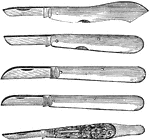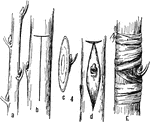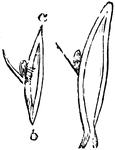Clipart tagged: ‘budding’
Body-budding
This illustration shows a tree that has been body-budded. It has two buds that had been killed by bud-moth…

Bud and Graft
This illustration shows a tree that has been both branch-budded and grafted. Buds inserted in August.…

Budding
(a) twig having suitable buds to use; (b) method of cutting the bud off; (c) how the bark is cut; (d)…

Budding Knives
Some blades, such as the first two, are made with a rounded point to cut the bark without the knife…

S. Cerevisiae Cell Multiplication
"Various stages of cell multiplication by budding of Saccharomyces cerevisiae." -Stevens, 1916

Flute-Budding
In flute budding a cylinder of bark is removed from the stock, and a piece of twig in a similar size…

Ring Budding
A ring of bark is removed in ring budding and replaced with a piece from a larger branch. When replaced…

Budding Grafting
"Budding. a, Budstick; b, T-shaped cut in bark of stock; c, bud ready for insertion; d, stock with bud…

Rose Budding
This is a tall briar with three shoots. A shows the shoot slit for the bud. B shows the bud inserted.…
Branch showing Rose Buds
This is a branch showing buds. The lower buds are the most suitable because they are in firmer wood.…

Bud Taken from Rose Budding
The left figure shows a bud taken from a budding branch. The right figure shows wood removed from the…

Shoots of Briar
Shoots of briar must be cut back before the rose buds once the buds are safely established.

Shield-Budding
"The simplest and most generally practised form of budding is that called Shield budding or T-budding.…

Shield Budding
In shield-budding the bark should first have two incisions, a length wise incision one inch long, and…


